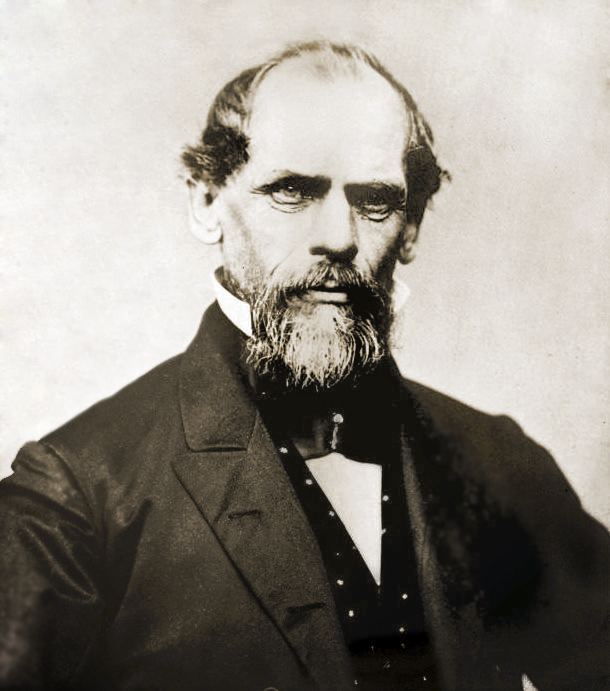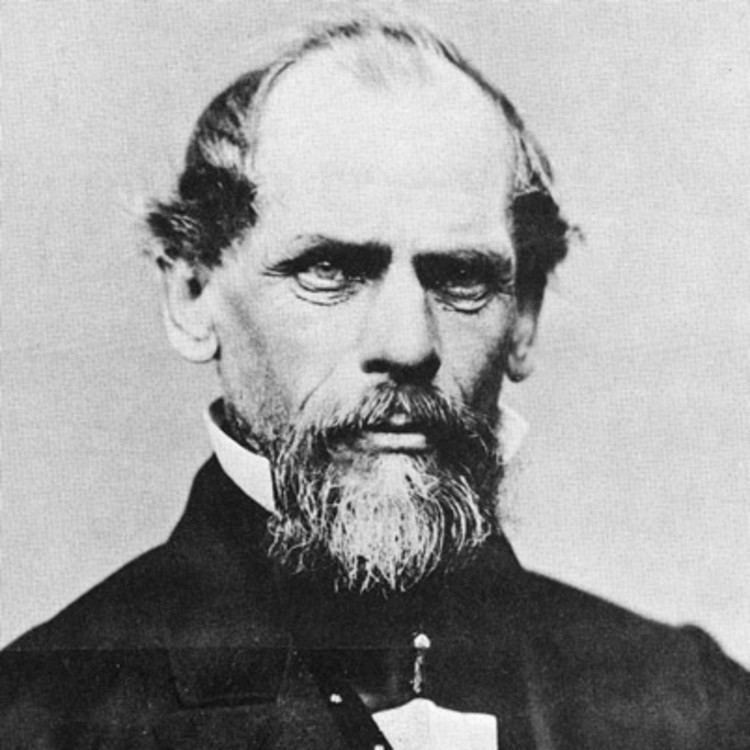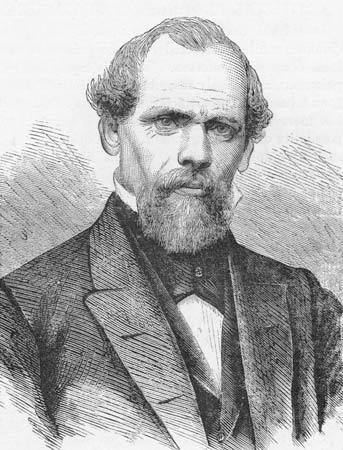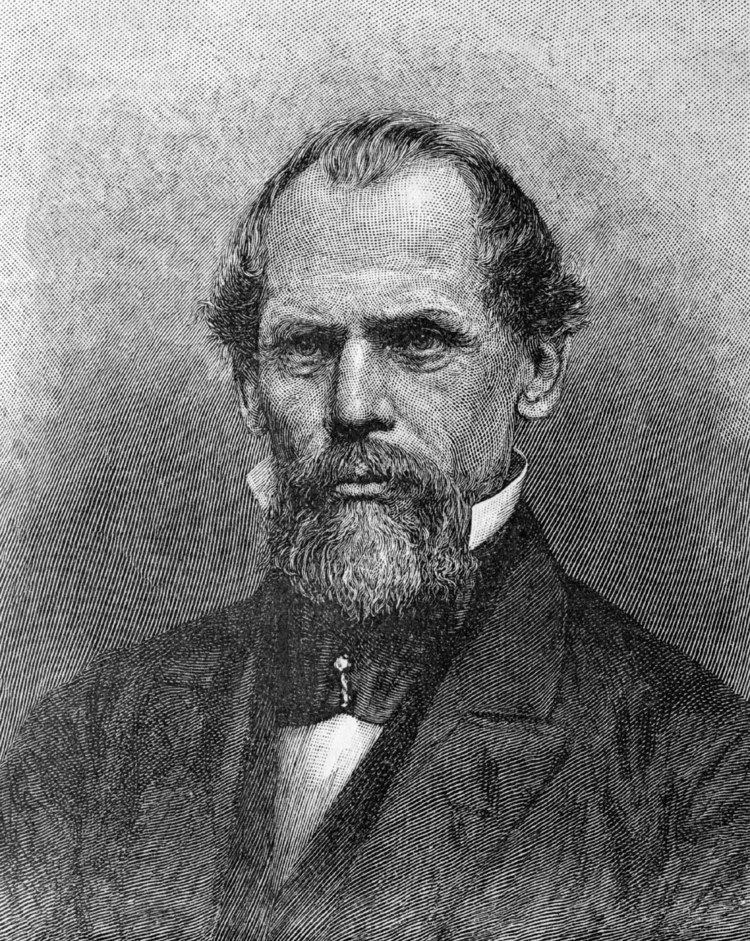Nationality Prussian | Name John Roebling | |
 | ||
Full Name Johann August Robling Known for Brooklyn BridgeCovington-Cincinnati Bridge | ||
Donald j trump and john a roebling inducted into the german american hall of fame
John Augustus Roebling (born Johann August Röbling; June 12, 1806 – July 22, 1869) was a German-born American civil engineer. He designed and built wire rope suspension bridges, in particular the Brooklyn Bridge, which has been designated as a National Historic Landmark and a National Historic Civil Engineering Landmark.
Contents
- Donald j trump and john a roebling inducted into the german american hall of fame
- John A Roebling and the Brooklyn Bridge Hidden Genius
- Education
- Career
- Death
- Legacy
- Projects
- Honors
- Personal life
- References

John A. Roebling and the Brooklyn Bridge - Hidden Genius
Education

At first John attended the gymnasium in Mühlhausen. Recognizing his intelligence at a young age, Roebling's mother, Friederike Dorothea Roebling arranged for him to be tutored in mathematics and science at Erfurt by Ephraim Salomon Unger. He went to Erfurt when he was 15. In 1824 he passed his Surveyor's examination and returned home for a year. In 1824 he enrolled for two semesters at the Bauakademie in Berlin where he studied architecture and engineering under Martin Friedrich Rabe (1765–1856), bridge construction and foundation construction under Johann Friedrich Dietlein (1782–1837), hydraulics under Johann Albert Eytelwein (1764–1848), and languages. Roebling also attended lectures of the philosopher Hegel. Roebling developed an interest in natural philosophy and many years later he worked on a 1000-page treatise about his own concepts of the universe.

In 1825 Roebling got a government job at Arnsberg, Westphalia, working on military road building for four years. During this period he made sketches for suspension bridges. In 1829 he returned to his home to work out his final thesis and prepare for his second engineer examination. For unknown reasons, he never took the examination.
Career

On May 22, 1831, Roebling left Prussia with his brother Carl and Johann Adolphus Etzler, the technological utopianist. Economic mobility and career advancement were difficult for engineers in Prussian society. The Napoleonic Wars, which lasted until 1815, had suppressed investment in infrastructure. This period in European history left Prussia with political unrest, as authoritarian governments took the places of democratic ones. Etzler had ideas about creating a utopia in the United States, but disputes arose en route, and the group split. John and Carl purchased 1582 acres (6.4 km²) of land on October 28, 1831, in Butler County, Pennsylvania with the intent to establish a German settlement, called Saxonburg. Most of the other settlers remained with Etzler. The John Roebling House at Saxonburg was listed on the National Register of Historic Places in 1976.

John Roebling and his brother arrived in the United States at an interesting time. The nation was in the later stages of an economic boom, which ended in the Panic of 1837. Farmers were deeply affected by it. A dominant mode of thought in America would be called manifest destiny by the 1840s. Transportation between eastern industrial hubs and frontier farming markets had become a matter of both national and popular interest. Many transportation projects were underway near the location Roebling chose for his colony, but instead of continuing in the engineering profession, he took up farming. After five years he married Johanna Herting, a tailor's daughter.
Agrarian work was unsatisfactory to John Roebling, and the colony attracted very few settlers. In 1837, after the death of his brother and the birth of his first child, he returned to engineering as a vocation.
Roebling's first engineering work in America was devoted to improving river navigation and canal building. He spent three years surveying for railway lines across the Allegheny Mountains, from Harrisburg to Pittsburgh, for the state of Pennsylvania. In 1840 he wrote to suspension bridge designer Charles Ellet, Jr., offering to help with the design of a bridge near Philadelphia:
The study of suspension bridges formed for the last few years of my residence in Europe my favourite occupation ... Let but a single bridge of the kind be put up in Philadelphia, exhibiting all the beautiful forms of the system to full advantage, and it needs no prophecy to foretell the effect which the novel and useful features will produce upon the intelligent minds of the Americans.
Roebling began producing wire rope at Saxonburg in 1841. At that time canal boats from Philadelphia were transported over the Allegheny Mountains on railroad cars to access waterways on the other side of the mountains, so that the boats could continue to Pittsburgh. The system of inclines and levels that moved the boats and conventional railroad cars was a state-owned enterprise, the Allegheny Portage Railroad. The railroad cars were pulled up and down the inclines by a long loop of thick hemp rope, up to 7 centimeters thick. The hemp ropes were expensive and had to be replaced frequently. Roebling remembered an article he read about wire ropes. Soon after, he started developing a 7-strand wire rope at a ropewalk that he built on his farm.
In 1844 Roebling won a bid to replace the wooden canal aqueduct across the Allegheny River with the Allegheny Aqueduct. His design encompassed seven spans of 163 feet (50 m), each consisting of a wooden trunk to hold the water supported by a continuous cable made of many parallel wires, wrapped tightly together, on each side of the trunk. This was followed in 1845 by building a suspension bridge over the Monongahela River at Pittsburgh. In 1848 Roebling undertook the construction of four suspension aqueducts on the Delaware and Hudson Canal. During this period, he moved to Trenton, New Jersey. In Trenton, Roebling built a large industrial complex for wire production. This complex inspired the Trenton, New Jersey motto on Trenton's Lower Trenton Bridge.
Roebling's next project, starting in 1851, was a railroad bridge connecting the New York Central and Great Western Railway of Canada over the Niagara River, which would take four years. The bridge, with a clear span of 825 feet (251 m), was supported by four, ten-inch (25 cm) wire cables, and had two levels, one for vehicles and one for rail traffic.
While the Niagara bridge was being built, Roebling undertook a railway suspension bridge across the Kentucky River, which required a clear span of 1,224 feet (373 m). The anchorage and stone towers were completed, and the cable wire delivered along with the material for the superstructure, when the railway company became insolvent. The bridge construction was halted, and was later finished as the first cantilever bridge in the US, with a truss for carrying the railway track.
In 1859 Roebling completed another suspension bridge at Pittsburgh. Its total length was 1,030 feet (314m), consisting of two main spans of 344 feet (105 m) each, and two side spans of 171 feet (52 m) each.
The American Civil War brought a temporary halt to Roebling's work. However, in 1863 building resumed on a bridge over the Ohio River at Cincinnati which he had started in 1856 and halted due to financing; the bridge was finished in 1867. The Cincinnati-Covington Bridge, later named the John A. Roebling Suspension Bridge, was the world's longest suspension bridge at the time it was finished.
Death
In 1867 Roebling started design work on what is now called the Brooklyn Bridge, spanning the East River in New York. On June 28, 1869 at Fulton Ferry, while he was standing at the edge of a dock, working on fixing the location where the bridge would be built, his foot was crushed by an arriving ferry. His injured toes were amputated. He refused further medical treatment and wanted to cure his foot by "water therapy" (continuous pouring of water over the wound). His condition deteriorated. He died on July 22, 1869 of tetanus at the home of his son on Hicks Street, in Brooklyn Heights. It was just 24 days after the accident. Roebling is buried in the Riverview Cemetery in Trenton, New Jersey.
Legacy
Roebling devised "an equilibrium strength approach, in which equilibrium is always satisfied but compatibility of deformations is not enforced." This was essentially an approximation method similar to the force method: First, Roebling computed the dead and live loads, then divided the load between the cables and the stays. Roebling added a large safety factor to the divided loads and then solved for the forces. This approach gave a sufficiently accurate analysis of the structure given the assumption that the structure was sufficiently ductile to handle the resulting deformation (Buonopane, 2006).
Projects
Honors
Personal life
Roebling was the youngest of four children. He was baptized in the Lutheran church Divi Blasii in Mühlhausen. As a young boy he played the bass clarinet and the french horn. He also exhibited great artistic talent for sketches and paintings. His father owned a small tobacco shop, but the business was insufficient to provide livelihood for all three sons. Roebling's sister Friederike Amalie married Carl August Meissner, a poor merchant in the town, and his oldest brother Herman Christian Roebling prepared to take over the tobacco shop.
John Roebling and Johanna Herting had nine children:
Roebling's son Washington Roebling and his daughter-in-law Emily Warren Roebling continued his work on the Brooklyn Bridge. His son Ferdinand expanded his wire rope business. His son Charles Roebling designed and invented a huge 80 ton wire rope machine and founded the town of Roebling, New Jersey where the John A. Roebling's Sons company steel mill was built. His grandson Washington A. Roebling II perished on the RMS Titanic. His great-grandson Donald Roebling was a noted philanthropist and inventor who devised the amphtrack.
